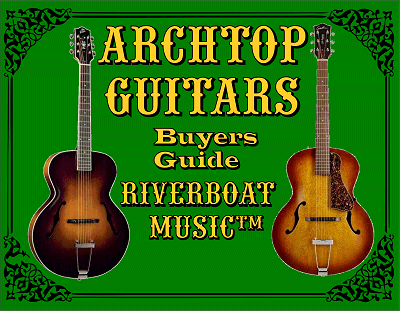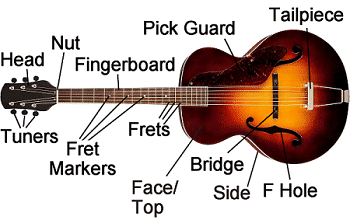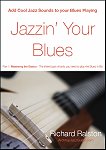 | |||
 |
5-string - 6-string - 4-string Others - Accessories |
||
Dreadnoughts - Archtops Classical - Parlor Starter - Jumbo - Tenor |
|||
Saxophones |
|||
 | |||
 |
5-string - 6-string - 4-string Others - Accessories |
||
Dreadnoughts - Archtops Classical - Parlor Starter - Jumbo - Tenor |
|||
Saxophones |
|||
Written by Paul D. Race for
 , ,  , and , and  |
|
Archtop Guitar Buyers's Guide, from Riverboat Music(tm) As Jazz developed in the early 20th century, evolving Jazz orchestras wanted to move from banjo to guitar. The problem was that the old traditional flattops (what we call "parlor guitars" today) were not very loud. Gibson apparently believed that he could make the guitar louder by making an arch top (like a violin) so it wouldn't require bracing. Gibson literally carved the arched top out of a block of wood, a technology that is seldom used today. He also increased the size to increase the volume. But the round hole on the front of the things made the guitar "boomy" in the low midrange. In 1922, master luthier Lloyd Loar was working for Gibson when he tried changing to F holes to reduce the boominess. Though his "L-5" was less than successful at first, it eventually set the standard for "Jazz guitar" for half a century. The following illustration shows the parts of a typical archtop.  In those days, guitar was part of the rhythm section of the orchestra, along with the piano, bass, and drums. Some bandleaders prized it more for the unique "chunk" of the strummed instrument than for any melodic, or even harmonic potential.
Eventually "cutaways" were added to allow players easier access to the higher frets. When the guitar pickup was invented, the first guitars to be amplified were archtops, because they were more resistant to feedback than flat-tops. However, the Gibson corporation began using laminated tops on the electric models, since they were going to be amplified anyway. Laminated tops are not carved out - each thin layer is dampened and put into a mold that forces it into an arched shape; then the layers are combined and glued together. As cumbursome as that sounds, it's still a lot more efficient than carving the top, and consequently cheaper. Electrified archtops became a staple of Country and Western music and "Western Swing," as well as Jazz and Blues. Then shallower bodies were introduced - which made the electrified guitars easier to handle and even more resistant to feedback. The resulting "semi-hollow-body" guitars were useful not only in jazz, but in many kinds of early Rock and Roll. They were especially popular with groups that drew on "Folk-Rock" roots like the Byrds and Buffalo Springfield. That said, this site focuses on acoustic music, so we'll let you sort out the electric versions on your own. As an acoustic instrument, a full-bodied archtop with a solid top has a lot of volume, especially in the low and midrange tones. If you're playing roots music, you may find it helpful for Blues. You may find it very helpful to set a contrast to the treble-rich instruments typical in "Mountain Music" and its offspring, including Bluegrass. It's far less common in Folk music than roundhole styles like the Dreadnought, possibly because manufacturing of archtops had dropped off before the Folk Revival. Shopping UsedMost of the classic archtops were built before the design of modern necks, with adjustable truss rod. In addition, when improperly stored, that curved solid face could develop contours that make the instrument unplayable. Consequently, it's relatively hard to find used full-bodied archtops in playable condition. Surprisingly, I started on one, an S.S. Stewart whose neck had started to bow in the wrong direction but was still playable. My sister got it from a pawn shop about 1965 and it's been in the family ever since.My quick "Craigs' List" poll shows two Harmony Montery models - one in good condition for about $400, one basket case for $135. Neither one would be a great guitar - the top is laminated birch and the "steel reinforcement" in the neck is a piece of v-shaped sheet steel shot lengthwise into it, so if it ever starts to bow, there's very little to stop it. But if either is or can be made playable, they might be fun to own as a novelty. (The original Harmony tuners have to go by the way). There is also a Chinese-built Loar LH-309 (no relationship at all to Lloyd Loar, who designed the L-5) - like most Chinese instruments in this price range, you might luck out and get a good one, and you might not. The owner is asking nearly what he paid for it, though. The "best bet" is probably an Eastman AR805-c, handbuilt in China to exacting standards, and generally well-received. The downside is that you pay "custom" prices for such beasts - the owner of this one wants $1500 for it, and it was quite a bit more new. By now, you've probably noticed that - except for Harmony student models - I found nothing like a US-made vintage large-body arch-top. So I broadened my search to eBay (where I've been stung as often as not buying musical instruments). I found no playable US-built solid-topped full-bodied arch-tops of any age under $1000, and very few under $1500, though I found many beaters, "project guitars" (basket cases), and laminated Silvertones, Kays, etc., with the same potential and the same potential problems as the Harmonies I found locally. In other words, if you want to play a vintage arch-top that has the projection and tone of the old Jazz, Blues, and Mountain Music arch-tops, you will either need to inherit one, spend "real money," or "roll the dice" on beater. If you do go out to look at a used one, pay special attention to the neck - that's the first place they're likely to go wrong. Shopping NewSince we're looking at guitars we plan to use "acoustically," I didn't look too closely at many laminated guitars, although the laminated Godin "Fifth Avenue" family of guitars gets good reviews for the price. To get a solid-topped US-made archtop took me into the stratosphere quickly. But there were a few mid-priced Chinese-made solid-topped full-sized instruments that might be worth taking a chance on. If you can find one in a store that a knowledgeable and reliable luthier or repair person has set up, don't feel bad about paying list price for the thing. The laborer is worthy of his hire, after all. And having a chance to try it out and inspect it before you bring it home is worth helping him or her pay the rent.If you do wind up ordering an archtop (or any musical instrument more complicated than a flutophone) online, be sure to have a pro check it over for shipping damage and manufacturing defects as soon as it arrives at your house. I've had about a 40% success rate ordering off-brand Chinese instruments online, and about a 60% success rate with brand name Chinese instruments (like Fender, Gretsch, Dean, etc.) Outside of possible shipping problems, the real problem in quality control. You might get one that seems perfect, then order another for a loved one and get one that is barely a musical instrument. Or the reverse - you might get a piece of junk, and send it back, and the next one be very nice. What's your defense? Immediate inspection and setup by a pro. As one more alternative, you might also try shopping at mom-and-pop stores like Elderly, where they inspect and - if necessary - set up ever instrument they sell. Their "archtop acoustic guitar" page lists everything from high-priced collectibles to new Chinese-made guitars, which I would trust a lot more coming from their shop than coming straight on the boat from China. The list on their Used Archtop Guitars page varies from week to week, but often includes guitars that are priced reasonably compared, say, to the same guitar from an eBay seller you know nothing about. ExamplesTo give you some idea of what you could get in a reasonable price range, here are some Chinese-made guitars that may be worth checking out. Except for the Godin, they are all solid topped. Except for the Godin, they all have a record of very uneven quality control, so my warning to have anything you order online checked out and set up by a pro goes double here. You'll also notice that I don't have any really high-end instruments here. I don't really recommending that you buy a high-end archtop online, unless you're in an area where they're impossible to get otherwise. But the truth is, the higher-end archtop models seldom show up new online. If you're looking for an upgrade instrument, you may have a "quest for the Holy Grail' experience ahead of you. (Elderly Music's new and used archtop guitar places might be a good place to start the quest.) When you do buy, whatever you buy, please either:
Honarable Mention from "Down Under"I have to add this link because I know this luthier has devoted a good portion of his life building custom archtops for jazz players. These are "high-end" guitars, so they're definitely not for beginners. They're also made in New Zealand, so they provide our "down under" friends a great resource. has devoted a good portion of his life building custom archtops for jazz players. These are "high-end" guitars, so they're definitely not for beginners. They're also made in New Zealand, so they provide our "down under" friends a great resource.
Rich Ralston, not only builds great guitars. He's also published some great, free, downloadable lessons for adding jazz licks to popular blues progressions called Jazzin' Your Blues. If you stop by either of his sites, tell him I sent you. ConclusionWhatever instrument you choose and however you get it into your household, we wish you the best and hope it brings countless hours of enjoyment. Please check back for updates, and contact us with any questions, corrections, additions, or "reader responses."
Note about Suppliers: While we try to help you get the instruments and other products you want by recommending suppliers with a good record of customer service, all transactions between you and the supplier you chose are governed by the published policies on the supplier's web site. So please print off any order confirmation screens and save copies of invoices, etc., so you can contact the appropriate supplier or invoke the product warranty should any problems occur.* Note about Ordering Musical Instruments Online: Buy only from folks with a reasonable return policy and be sure to have any musical instrument you ordered online checked over by a professional as soon as you receive it. Every musical instrument has the potential for being damaged in shipment, even if the box looks fine when you get it. In addition, musical instruments shipped across the Pacific have a very high percentage of manufacturing defects. If you look at online reviews, a surprising percentage of the one-star reviews say something like "By the time I realized it was damaged (or had a critical manufacturing defect), the period for returns had run out, so now I'm stuck with a useless piece of . . . . " Yes, the manufacturer should have better quality control, and the store should pack things better. But in the end, you are responsible for making certain that an instrument or product will serve your needs while you still have time to return it. Note about Buying Musical Instruments New: Before you spend $2000 on an instrument that will be worth $800 once you get it home, check out the used market for that sort of instrument in your area. Depending on where you live, or what kind of instrument you're looking for, it may not be an option. But if you can get a used professional instrument for the same price as a new student instrument, it is often worth taking the risk. Especially if you have a knowledgeable friend who can go along and check it out for you. In fact, many of our pages include links to articles on how to shop for used instruments of various types. However, we recognize that many folks have limited access to good used instruments, and everyone needs to see what is available in the various price ranges. So we do list, when possible, live links to real vendors with a good return policy, in case they're your best choice for getting what you want. Again, once you buy something, your satisfaction is between you and the vendor. Note about Availability and Pricing: Although I try to keep an eye on things and to recommend products that are reasonably available, the model train market does fluctuate, and any product on this page may change price or become unavailable without prior notice. If you "click through" to see details on a product, and nothing happens at all, or you are routed to a supplier's home page, please let me know and I will remove the product from the online catalog until I can find a replacement or another supplier. For more detailed information about why products seem to come and go and why I have stopped listing prices for most products, please see my article "About Pricing and Availability." *Here's an irony: every year, I receive about a dozen complaints from folks who have never been to my sites before, angry that a deal between that person and a vendor or manufacturer I recommend went south (in their opinion). They "googled" the product, saw my recommendation or review, then e-mailed me to tell me they were going to sue me or report me to the Better Business Bureau for personally ripping them off by recommending a product they had bought from someone else. Ninety-nine times out of a hundred, the problem is really because the customer didn't read the whole ad, or ordered the wrong thing, or threw away his paperwork and doesn't know where he bought it from, etc. I'm always polite, and sometimes I can even help them get things straightened out with the vendor, but it's not, technically, my problem. Click here to return to the text.
|  |
||||||||||||||||||||||
| Visit related pages and affiliated sites: | ||||||
| - Music - | ||||||

|
 |
 |

|

|

|
|

|

|

|

|

|

|
|
| - Trains and Hobbies - | ||||||
 |

|

|  |
 |

|
|
| - Christmas Memories and Collectibles - | ||||||
 |

|
 |

|
 |

|
|
| - Family Activities and Crafts - | ||||||
 |

|

|

|

|

|
|